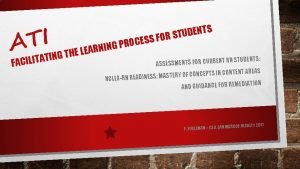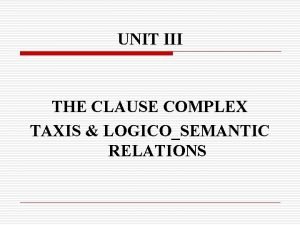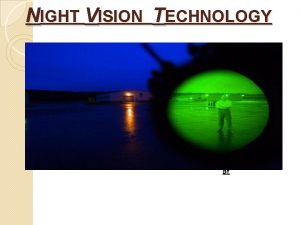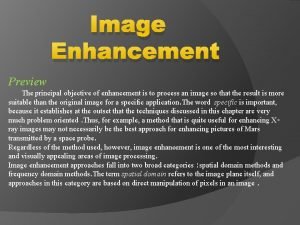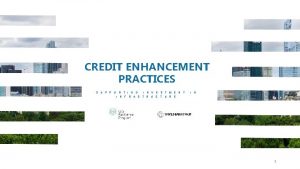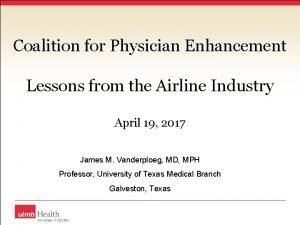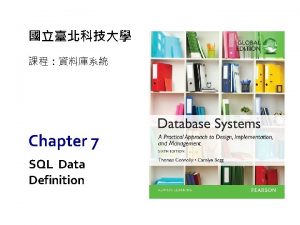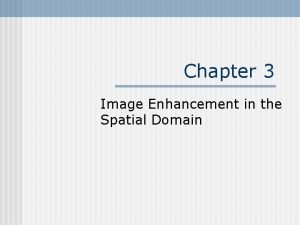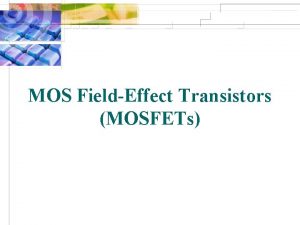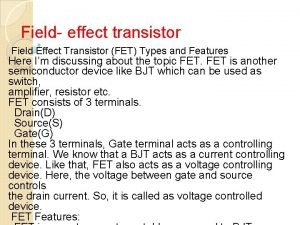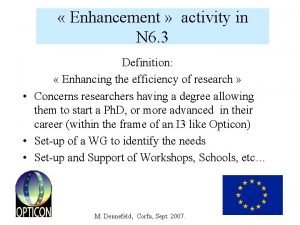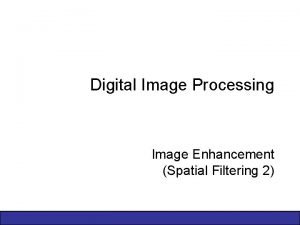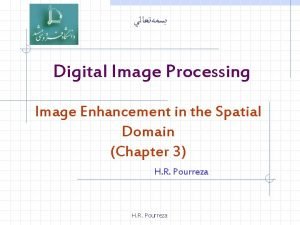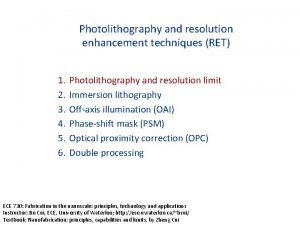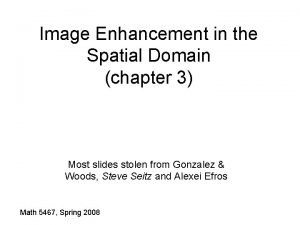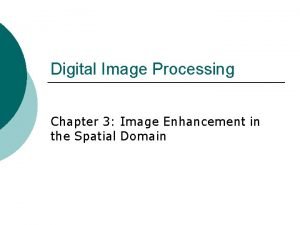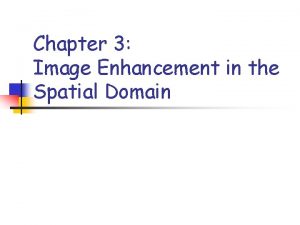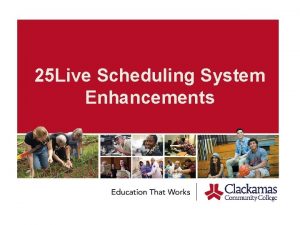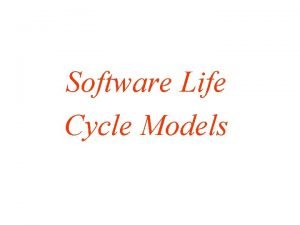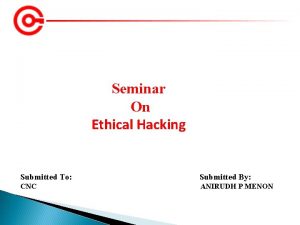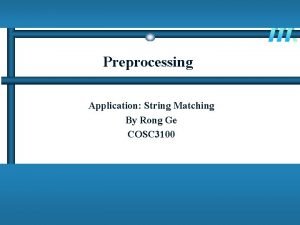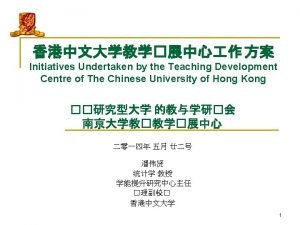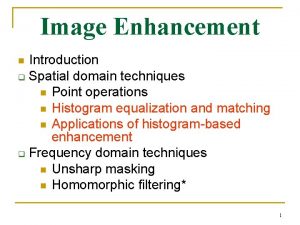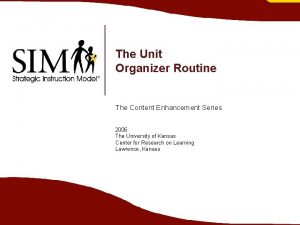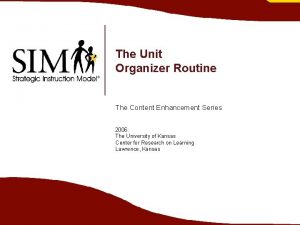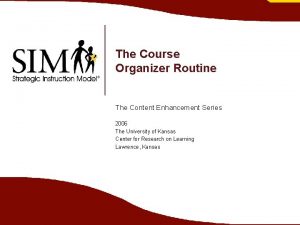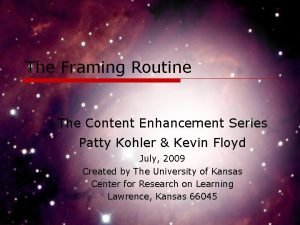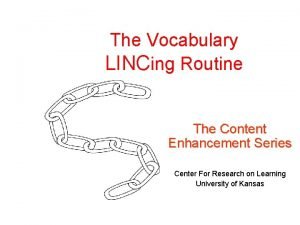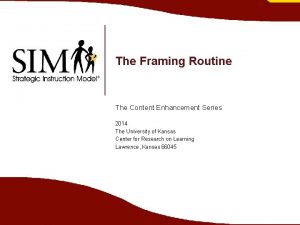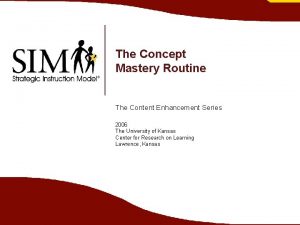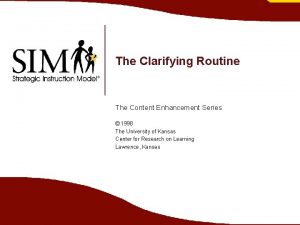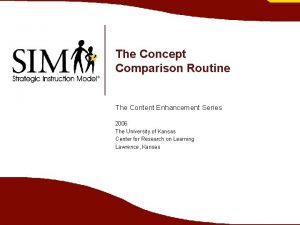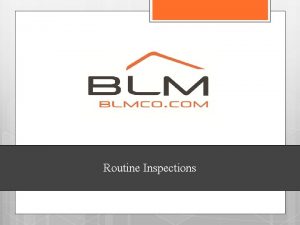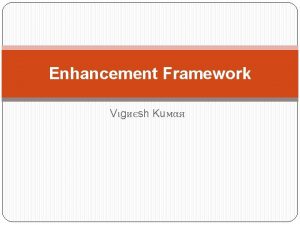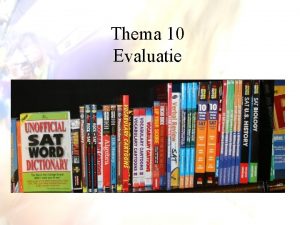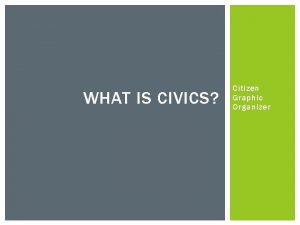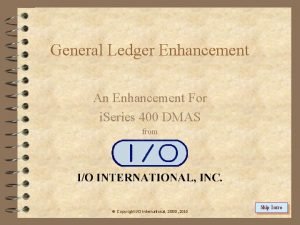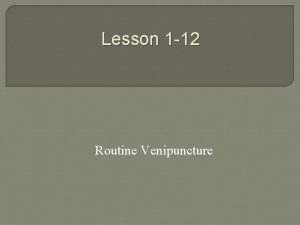The Lesson Organizer Routine The Content Enhancement Series

















































- Slides: 49

The Lesson Organizer Routine The Content Enhancement Series 2006 The University of Kansas Center for Research on Learning Lawrence, Kansas

Content Enhancement A way of teaching an academically diverse group of students in which: – Both group and individual needs are valued and met; – The integrity of the content is maintained; 2 University of Kansas Center for Research on Learning 2006

Content Enhancement A way of teaching an academically diverse group of students in which: – Critical features of the content are selected and transformed in a manner that promotes student learning; and – Instruction is carried out in a partnership with students. 3 University of Kansas Center for Research on Learning 2006

Guidebooks in the Content Enhancement Series • Routines for planning and leading learning – Course Organizer Routine – Unit Organizer Routine – Lesson Organizer Routine 4 University of Kansas Center for Research on Learning 2006

Guidebooks in the Content Enhancement Series • Routines for exploring text, topics, and details – – Clarifying Routine Framing Routine Survey Routine ORDER Routine 5 University of Kansas Center for Research on Learning 2006

Guidebooks in the Content Enhancement Series • Routines for teaching concepts – Concept Anchoring Routine – Concept Comparison Routine – Concept Mastery Routine 6 University of Kansas Center for Research on Learning 2006

Guidebooks in the Content Enhancement Series • Routines for increasing performance – Teaching Cause and Effect Routine – The Question Exploration Routine – The Recall Enhancement Routine – The Vocabulary LINCing Routine – The Quality Assignment Routine 7 University of Kansas Center for Research on Learning 2006

Purpose • The Lesson Organizer Routine helps students to: – Consolidate the main idea of the content into a paraphrase. – See how the various parts of the content fit together. – Relate the content to their background knowledge. 8 University of Kansas Center for Research on Learning 2006

Purpose • The Lesson Organizer Routine helps students to: – Focus attention on important relationships in the content. – Remember important strategies needed for learning. – Record a way to organize information for later studying and use. – Approach the lesson with a purpose. 9 University of Kansas Center for Research on Learning 2006

Supporting Research • The Lesson Organizer Routine was studied in secondary content-area classes (grades 7 -12) characterized by diversity. • In each study, teachers learned the Lesson Organizer Routine easily and student learning gains were observed by both teachers and researchers. 10 University of Kansas Center for Research on Learning 2006

Supporting Research • In each study, students gained an average of at least 10 to 20 percentage points on tests or tasks that required students to demonstrate learning. Teachers continued using the routine after the studies were completed. 11 University of Kansas Center for Research on Learning 2006

Supporting Research • These results were achieved when teachers: – received 2 -3 hours of instruction in the routine – had opportunities to discuss the routine with colleagues – spent the necessary time to plan and use the routine for more inclusive teaching – taught students how to participate in and use the routine – used the routine regularly over time 12 University of Kansas Center for Research on Learning 2006

Supporting Research • In general, the greatest gains were seen in classes where teachers had the highest expectations for student learning and were consistent in their use of the routine over time. 13 University of Kansas Center for Research on Learning 2006

Components of The Lesson Organizer Routine The Lesson Organizer Teaching Device The CRADLE Linking Steps The Cue-Do-Review Sequence 14 University of Kansas Center for Research on Learning 2006

The Lesson Organizer Teaching Device • Is a visual device that: – is used under teacher guidance – focuses attention on critical outcomes – identifies critical content features – prompts elaboration on critical points – helps make relationships concrete 15 University of Kansas Center for Research on Learning 2006

The Lesson Organizer Teaching Device • Is a visual device that: – is designed to enhance student… • . . . organization • . . . understanding • . . . remembering • . . . responses • . . . belief in the value of the content 16 University of Kansas Center for Research on Learning 2006

The Teaching Device: The Lesson Organizer 2 Relationships 4 UNIT or BACKGROUND DATE: 1 5 Lesson Map LESSON TOPIC is a bo ut 6 Challenge Question 7 Self-test Questions 17 University of Kansas Center for Research on Learning 2006 8 Tasks NAME: 3 Task-Related Strategies

The Teaching Device: The Lesson Organizer 4 UNIT or BACKGROUND DATE: 11/21 NAME: Ms. Mendez Causes of the Civil War (sectionalism) was based on Differences between the areas Areas of the U. S. and included Economic Differences 2 Leaders across the U. S. Social Differences LESSON TOPIC 1 3 Task-Related Strategies Economic Differences compare / contrast self-questioning is about 5 Lesson Map North Events in the U. S. and included Political Differences Relationships was influenced by became greater with emerged because of the conflicting interests in the way people made a living. . . between. . and the West the South 6 Challenge Question What are the types of economic differences that appear between groups of people in a community? Can tension exist? 7 Self-test Questions 8 Tasks 1. What were the economic characteristics of the three sections? 1. First half of class, discuss as group the economic differences. 2. How did the economic similarities and differences fuel the fires of war? 2. Second half of class, work in groups to answer the challenge question on page 213 of the text. 18 University of Kansas Center for Research on Learning 2006

The Teaching Device: The Lesson Organizer 4 UNIT or BACKGROUND DATE: 11/21 NAME: Ms. Mendez Causes of the Civil War (sectionalism) was based on Differences between the areas Areas of the U. S. and included Economic Differences 2 Leaders across the U. S. Social Differences LESSON TOPIC 1 3 Task-Related Strategies Economic Differences compare / contrast self-questioning is about 5 Lesson Map North Events in the U. S. and included Political Differences Relationships was influenced by became greater with emerged because of the conflicting interests in the way people made a living. . . between. . and the West The Lesson Topic the South This information helps students focus on the main idea of the lesson. It is usually 6 Challenge Question one or two words long. 8 Tasks Self-test Questions What are the types of economic differences that appear between groups of people in a community? Can tension exist? 7 1. What were the economic characteristics of the three sections? 1. First half of class, discuss as group the economic differences. 2. How did the economic similarities and differences fuel the fires of war? 2. Second half of class, work in groups to answer the challenge question on page 213 of the text. 19 University of Kansas Center for Research on Learning 2006

The Teaching Device: The Lesson Organizer 4 UNIT or BACKGROUND DATE: 11/21 NAME: Ms. Mendez Causes of the Civil War (sectionalism) was based on Differences between the areas Areas of the U. S. and included Economic Differences 2 Political Differences Relationships 1 Events in the U. S. Leaders across the U. S. and included Social Differences Relationships LESSON TOPIC 3 Task-Related Strategies Economic Differences compare / contrast self-questioning This information identifies the most important relationships West to look for in the content of the lesson. is about 5 Lesson Map North was influenced by became greater with emerged because of the conflicting interests in the way people made a living. . . between. . and the South 6 Challenge Question What are the types of economic differences that appear between groups of people in a community? Can tension exist? 7 Self-test Questions 8 Tasks 1. What were the economic characteristics of the three sections? 1. First half of class, discuss as group the economic differences. 2. How did the economic similarities and differences fuel the fires of war? 2. Second half of class, work in groups to answer the challenge question on page 213 of the text. 20 University of Kansas Center for Research on Learning 2006

The Teaching Device: The Lesson Organizer 4 UNIT or BACKGROUND DATE: 11/21 NAME: Ms. Mendez Causes of the Civil War (sectionalism) was based on Differences between the areas Areas of the U. S. and included Economic Differences 2 Events in the U. S. Social Differences LESSON TOPIC 1 3 Task-Related Strategies Economic Differences compare / contrast self-questioning is about 5 Lesson Map the conflicting interests in the way people made a living. . . between. . Task-Related Strategies North Leaders across the U. S. and included Political Differences Relationships was influenced by became greater with emerged because of and the West the South the This information identifies strategies that students might use to gain, store, or express information and work efficiently 6 Challenge Question to achieve the goals of the lesson. 8 Tasks Questions 7 Self-test What are the types of economic differences that appear between groups of people in a community? Can tension exist? 1. What were the economic characteristics of the three sections? 1. First half of class, discuss as group the economic differences. 2. How did the economic similarities and differences fuel the fires of war? 2. Second half of class, work in groups to answer the challenge question on page 213 of the text. 21 University of Kansas Center for Research on Learning 2006

The Teaching Device: The Lesson Organizer 4 UNIT or BACKGROUND DATE: 11/21 NAME: Ms. Mendez Causes of the Civil War (sectionalism) was based on Differences between the areas Areas of the U. S. and included Economic Differences 2 Leaders across the U. S. Social Differences LESSON TOPIC 1 3 Task-Related Strategies Economic Differences compare / contrast self-questioning is about 5 Lesson Map North Events in the U. S. and included Political Differences Relationships was influenced by became greater with emerged because of the conflicting interests in the way people made a living. . . between. . and the The Unit or Background West the South This information shows graphically how the lesson is related to the unit in which it is 6 Challenge Questionembedded. What are the types of economic differences that appear between groups of people in a community? Can tension exist? 7 Self-test Questions 8 Tasks 1. What were the economic characteristics of the three sections? 1. First half of class, discuss as group the economic differences. 2. How did the economic similarities and differences fuel the fires of war? 2. Second half of class, work in groups to answer the challenge question on page 213 of the text. 22 University of Kansas Center for Research on Learning 2006

The Teaching Device: The Lesson Organizer 4 UNIT or BACKGROUND The Lesson Map DATE: 11/21 NAME: Ms. Mendez Causes of the Civil War (sectionalism) The Lesson Map includes a paraphrase of the topic and shows the lesson content is to be organized. Key words and relationships are included. was based on Differences between the areas Areas of the U. S. and included Economic Differences 2 Leaders across the U. S. Social Differences LESSON TOPIC 1 3 Task-Related Strategies Economic Differences compare / contrast self-questioning is about 5 Lesson Map North Events in the U. S. and included Political Differences Relationships was influenced by became greater with emerged because of the conflicting interests in the way people made a living. . . between. . and the West the South 6 Challenge Question What are the types of economic differences that appear between groups of people in a community? Can tension exist? 7 Self-test Questions 8 Tasks 1. What were the economic characteristics of the three sections? 1. First half of class, discuss as group the economic differences. 2. How did the economic similarities and differences fuel the fires of war? 2. Second half of class, work in groups to answer the challenge question on page 213 of the text. 23 University of Kansas Center for Research on Learning 2006

The Teaching Device: The Lesson Organizer 4 UNIT or BACKGROUND DATE: 11/21 NAME: Ms. Mendez Causes of the Civil War (sectionalism) was based on Differences between the areas Areas of the U. S. and included Economic Differences 2 and included Events in the U. S. Leaders across the U. S. and included Political Differences Social Differences The Challenge 1 LESSON TOPICQuestion 3 Task-Related Strategies Relationships Economic Differences compare / contrast self-questioning This area presents a question to spark discussion and help West students relate to the lesson's content. is about 5 Lesson Map North was influenced by became greater with emerged because of the conflicting interests in the way people made a living. . . between. . and the South 6 Challenge Question What are the types of economic differences that appear between groups of people in a community? Can tension exist? 7 Self-test Questions 8 Tasks 1. What were the economic characteristics of the three sections? 1. First half of class, discuss as group the economic differences. 2. How did the economic similarities and differences fuel the fires of war? 2. Second half of class, work in groups to answer the challenge question on page 213 of the text. 24 University of Kansas Center for Research on Learning 2006

The Teaching Device: The Lesson Organizer 4 UNIT or BACKGROUND Causes of the Civil War DATE: 11/21 NAME: Ms. Mendez (sectionalism) was based on emerged because of Differences between the areas Areas of the U. S. and included Economic Differences 2 became greater with Relationships compare / contrast 5 Lesson Map North was influenced by Events in the U. S. Leaders across the U. S. Self-Test Questions and included Political Differences and included Social Differences 1 LESSON TOPIC provides Strategies 3 Task-Related This information students Economic Differences self-questioning with questions they can ask themselves to review the content of in the way West the conflicting lesson. interests The questions require people made a living. . . between. . the student to think about important South relationships in the content. is about and the the 6 Challenge Question What are the types of economic differences that appear between groups of people in a community? Can tension exist? 7 Self-test Questions 1. What were the economic characteristics of the three sections? 2. How did the economic similarities and differences fuel the fires of war? 25 University of Kansas Center for Research on Learning 2006 8 Tasks 1. First half of class, discuss as group the economic differences. 2. Second half of class, work in groups to answer the challenge question on page 213 of the text.

The Teaching Device: The Lesson Organizer 4 UNIT or BACKGROUND DATE: 11/21 NAME: Ms. Mendez Causes of the Civil War (sectionalism) was based on Differences between the areas Areas of the U. S. and included Tasks Economic Differences 2 Events in the U. S. Social Differences LESSON TOPIC 1 Leaders across the U. S. and included Political Differences Relationships was influenced by became greater with emerged because of Economic Differences This information summarizes Lesson Map the required tasks, expectations, or assignments North associated with the lessons. 3 Task-Related Strategies compare / contrast 5 self-questioning is about the conflicting interests in the way people made a living. . . between. . and the West the South 6 Challenge Question What are the types of economic differences that appear between groups of people in a community? Can tension exist? 7 Self-test Questions 8 Tasks 1. What were the economic characteristics of the three sections? 1. First half of class, discuss as group the economic differences. 2. How did the economic similarities and differences fuel the fires of war? 2. Second half of class, work in groups to answer the challenge question on page 213 of the text. 26 University of Kansas Center for Research on Learning 2006

The CRADLE Linking Steps • Guide the teacher in ways to: – present the Lesson Organizer effectively – involve students in constructing and using the Lesson Organizer – elicit and make connections to the prior knowledge of students – focus student attention on learning 27 University of Kansas Center for Research on Learning 2006

The CRADLE Linking Steps • Consolidate Goals • Review Knowledge • Assemble a Visual Anchor • Describe and Map the Content • Link to Students’ Lives • Explore Questions and Tasks 28 University of Kansas Center for Research on Learning 2006

The Teaching Device: The Lesson Organizer 4 UNIT or BACKGROUND DATE: 11/21 NAME: Ms. Mendez Causes of the Civil War (sectionalism) was based on Differences between the areas Areas of the U. S. and included Economic Differences 2 Leaders across the U. S. Social Differences LESSON TOPIC 1 3 Task-Related Strategies Economic Differences compare / contrast self-questioning is about 5 Lesson Map North Events in the U. S. and included Political Differences Relationships was influenced by became greater with emerged because of the conflicting interests in the way people made a living. . . between. . and the West the South 6 Challenge Question What are the types of economic differences that appear between groups of people in a community? Can tension exist? 7 Self-test Questions 8 Tasks 1. What were the economic characteristics of the three sections? 1. First half of class, discuss as group the economic differences. 2. How did the economic similarities and differences fuel the fires of war? 2. Second half of class, work in groups to answer the challenge question on page 213 of the text. 29 University of Kansas Center for Research on Learning 2006

The Cue-Do-Review Sequence The overall instructional process that guides use of the Lesson Organizer and CRADLE Linking Steps. This instructional process involves: CUE • The teacher announces the Lesson Organizer and explains its use. 30 University of Kansas Center for Research on Learning 2006

The Cue-Do-Review Sequence The overall instructional process that guides use of the Lesson Organizer and CRADLE Linking Steps. This instructional process involves: DO • The teacher and class collaboratively construct the device using the CRADLE Linking Steps that “connect” the content to the needs and goals of students. 31 University of Kansas Center for Research on Learning 2006

The Cue-Do-Review Sequence The overall instructional process that guides use of the Lesson Organizer and CRADLE Linking Steps. This instructional process involves: REVIEW • Information presented in the Lesson Organizer is reviewed and confirmed. 32 University of Kansas Center for Research on Learning 2006

"Get Ready? " • Decide when to use the routine. • Collect needed materials. • Construct a draft. A. Specify and name the lesson topic. B. Identify and map unit or background knowledge. 33 University of Kansas Center for Research on Learning 2006

"Get Ready? " • Construct a draft. C. Identify and map critical lesson content and relationships. • keep it simple • place line labels • place relationship labels D. Specify important relationships. E. Generate critical self-test questions. F. Generate learning tasks and assignments. G. Specify task-related strategies. 34 University of Kansas Center for Research on Learning 2006

"Get Ready? " • Decide when to use the routine. • Collect needed materials. • Construct a draft. • Construct verbal components • Select implementation option 35 University of Kansas Center for Research on Learning 2006

Lesson Organizer Implementation Options Option 1 – Blank forms displayed on an overhead or chalkboard – Lesson framework is built from scratch – Students construct their own organizer on blank paper. Option 2 – Blank forms distributed to students – Teacher guides the class using a Lesson Organizer form on an overhead or chalkboard 36 University of Kansas Center for Research on Learning 2006

Lesson Organizer Implementation Options Option 3 – Partially completed forms distributed to students – Teacher and students add information Option 4 For a larger amount or complex information: – Fully constructed form distributed to students – Notes added – Questions discussed 37 University of Kansas Center for Research on Learning 2006

"Get Set!" • Choose lesson material. • Introduce the Lesson Organizers. • Describe how you will Cue the Lesson Organizer. • Describe how you will Do the routine. • Explain how you will Review the information. • Debrief. 38 University of Kansas Center for Research on Learning 2006

The Teaching Device: The Lesson Organizer 4 UNIT or BACKGROUND DATE: 3/10/03 NAME: Mr. Darters Cooperative Learning Group Work requires that you. . . Share Ideas 2 Relationships Compliment Others LESSON TOPIC 1 sequencing/cause and effect Exercise Self-Control Task-Related Strategies 3 visual imagery Exercise Self-Control is a 5 Lesson Map bo ut There are Rules for Exercising Self-Control keeping your cool when you are told that you have done something wrong There are Skill Steps for Exercising Self-Control Nonverbal skills for Exercising Self-Control Conditions for when to Exercising Self-Control 6 Challenge Question Recommend Changes Offer Help Do you ever get angry with others when you are working in your cooperative learning group? 7 Self-test Questions 1. How do your nonverbal signals affect how others react toyou? 2. What are the rules to remember when exercising self-control 3. What are the steps to the Exercise Self-Control Skill? ? 39 University of Kansas Center for Research on Learning 2006 8 Tasks 1. Demonstrate how to exercise self-control as you work in Cooperative Learning Groups. . 2. Audiotape your group work and turn it in before you leave

"Go!" • Use the routine explicitly. • Build lessons around organizers. • Close lessons with organizers • Evaluate your use of the routine. • Be creative. • Beware of the “pitfalls. ” 40 University of Kansas Center for Research on Learning 2006

Presentation Checks • Large enough to see from back of class? • Words, symbols, and lines legible? • Relationships clearly depicted? • Ideas presented concisely and meaningfully? • Ideas adequately separated with space and symbols? • Students could read and explain the parts? 41 University of Kansas Center for Research on Learning 2006

Presentation Checks • All words and labels were read? • Pointed to the important parts of the visual? • Cued students to take notes around the Lesson Organizer? • Made complete statements about each Lesson Organizer part? • Explained the relationships shown in the content map? 42 University of Kansas Center for Research on Learning 2006

"Win Win!" • Students Win! – Students learn what they are supposed to learn. – Students are personally satisfied with what and how they are learning. – Students' grades reflect how much they have learned. 43 University of Kansas Center for Research on Learning 2006

"Win Win!" • You Win! – Select a "growth target. " – Choose a way to learn. – Choose a support system. – Plan for confidence-building. – Debug. – Maximize the challenge. – Develop your "ensurance" policy. 44 University of Kansas Center for Research on Learning 2006

The Teaching Device: The Lesson Organizer 2 Relationships 4 UNIT or BACKGROUND DATE: 1 5 Lesson Map LESSON TOPIC is a bo ut 6 Challenge Question 7 Self-test Questions 45 University of Kansas Center for Research on Learning 2006 8 Tasks NAME: 3 Task-Related Strategies

The Teaching Device: The Lesson Organizer 4 UNIT or BACKGROUND DATE: 9/29 Mr. Stamp NAME: Indirect democracy - USA made of an Executive Branch 2 State government where political power is entrusted to representatives and responsibility is shared (called FEDERALISM) by the National government a Judicial Branch Relationships a Legislative Branch LESSON TOPIC 1 3 Legislative Branch compare and contrast self-questioning is a 5 Lesson Map bo ut includes Congress the part of government that makes the laws and includes The House of Representatives Characteristics Task-Related Strategies Responsibilities The Senate Characteristics laws passed in Congress is like having to ask both your science teacher 6 Challenge Question Getting and the history teacher if you can go on the pep club field trip. 7 Self-test Questions 8 Tasks 1. How are the House and the Senate alike and how are they different? 1. Take notes on the characteristics and responsibilities. 2. Read pages 45 -48 in the textbook. 3. Turn in Lesson Organizer for grading. 46 University of Kansas Center for Research on Learning 2006 Responsibilities

The Teaching Device: The Lesson Organizer 4 UNIT or BACKGROUND DATE: 3/10 NAME: Ms. Chavez Vertebrates Include fishes 2 amphibians Relationships reptiles LESSON TOPIC 1 mammals birds 3 Task-Related Strategies birds analogical self-questioning is a 5 Lesson Map bo ut the vertebrate that is built for flight and its how it evolved 6 Challenge Question its flight structures its orders and origins life activities importance In what ways are birds like airplanes? 7 Self-test Questions 1. How have birds adapted for flight? 2. How are birds important to the environment? 47 University of Kansas Center for Research on Learning 2006 8 Tasks 1. Read pages 520 -526 for tomorrow. 2. Complete model of a fertilized bird's egg. 3. Each person needs to turn in the answer to questions number 5 on page 218 after Cooperative Study Group work.

The Teaching Device: The Lesson Organizer 4 UNIT or BACKGROUND DATE: 11/15 Mr. Washington NAME: Working with Decimals word names 2 Relationships rounding 1 sequence percents fractions LESSON TOPIC decimals and Percents Task-Related Strategies dividing and paraphrasing 3 is a 5 Lesson Map bo ut how to describe parts of something in different ways and by changing percents to decimals changing percents to fractions to decimals and visa versa and changing decimals to percents 6 Challenge Question How can a father, a brother, an uncle, and a grandfather be described as one person? 7 Self-test Questions 1. How do you change a percent to a decimal? 2. How do you change a decimal to a percent? 3. How do you change a fraction to a percent? 4. How do you change a decimal to a fraction? 5. How do you change a a percent to a fraction? 48 University of Kansas Center for Research on Learning 2006 8 Tasks 1. Complete the problems on page 169 in the text. 2. In your math notebook, explain each step of the process that you used in order to complete problem 8 on page 169.

The Teaching Device: The Lesson Organizer 4 UNIT or BACKGROUND DATE: 11/15 Lesson Organizer NAME: Ms. Gaston short story setting 2 point of view character Relationships plot LESSON TOPIC 1 theme 3 plot sequencing/cause and effect Task-Related Strategies paraphrasing is a 5 Lesson Map bo ut the major set of actions in a story such as exposition (set up) 6 Challenge Question such as conflict such as climax such as resolution How are events in your life like a short story? 7 Self-test Questions 8 Tasks 1. What types of events in a story can lead to conflict? 1. List the components of the plot for the short story on pages 167 -174. 2. How are rising action and falling action related to the climax of a story? 2. Read the story on pages 176 -185 for tomorrow. 49 University of Kansas Center for Research on Learning 2006
 Real content and carrier content in esp
Real content and carrier content in esp Static content vs dynamic content
Static content vs dynamic content Ati grading rubric
Ati grading rubric Maclaurin series vs taylor series
Maclaurin series vs taylor series Heisenberg 1925 paper
Heisenberg 1925 paper Taylor series of composite functions
Taylor series of composite functions Taylor series lesson
Taylor series lesson P series server
P series server Shunt-series feedback example
Shunt-series feedback example Series aiding and series opposing
Series aiding and series opposing Arithmetic sequence sum formula
Arithmetic sequence sum formula Complex sentence
Complex sentence Family enhancement center
Family enhancement center Digital foil enhancement
Digital foil enhancement Mitomycin c prk
Mitomycin c prk Inverter nmos
Inverter nmos Image enhancement in night vision technology
Image enhancement in night vision technology Objective of image enhancement
Objective of image enhancement Inverse log transformation in image processing
Inverse log transformation in image processing Modular operational ration enhancement
Modular operational ration enhancement Credit enhancement definition
Credit enhancement definition Coalition for physician enhancement
Coalition for physician enhancement Integrity enhancement features of sql
Integrity enhancement features of sql Spatial filtering
Spatial filtering When using monomer liquid and polymer powder, you:
When using monomer liquid and polymer powder, you: Gamma correction image processing
Gamma correction image processing Triode region current
Triode region current Fet
Fet Academic enhancement
Academic enhancement Enhancement activity
Enhancement activity Image processing
Image processing Point processing in digital image processing
Point processing in digital image processing Combining spatial enhancement methods
Combining spatial enhancement methods Nerolac paints price 20 liter price
Nerolac paints price 20 liter price Resolution of photolithography
Resolution of photolithography What is enhancement in the spatial domain?
What is enhancement in the spatial domain? Miriam ködderitzsch-frank
Miriam ködderitzsch-frank Mask mode radiography
Mask mode radiography Combining spatial enhancement methods
Combining spatial enhancement methods Live enhancement
Live enhancement Software life cycle
Software life cycle Future enhancement of ethical hacking
Future enhancement of ethical hacking Contrast enhancement
Contrast enhancement Input enhancement in string matching
Input enhancement in string matching Centre for learning enhancement and research
Centre for learning enhancement and research Idl medical ent
Idl medical ent Revenue enhancement synergy
Revenue enhancement synergy Communication enhancement definition
Communication enhancement definition Edge enhancement
Edge enhancement Image enhancement in spatial domain
Image enhancement in spatial domain


